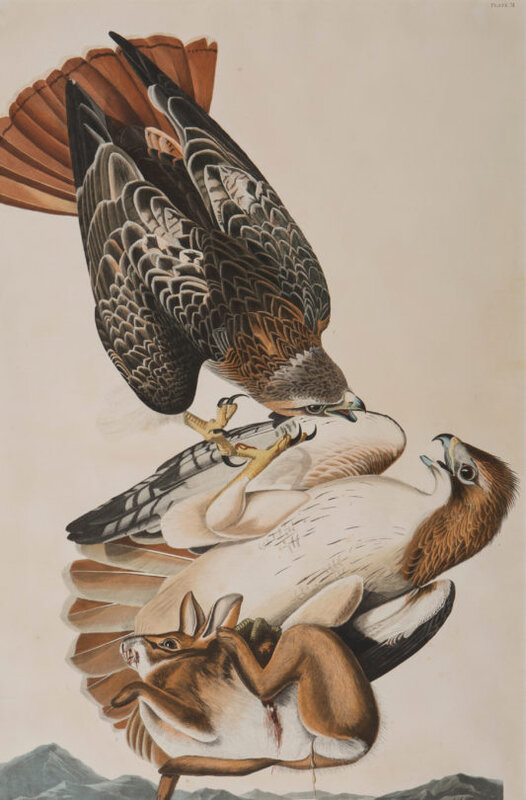
John James Audubon, White Heron, from The Birds of America, 1827–1838, hand-colored engraving with aquatint and etching on paper, sheet: approx. 25 × 38 inches. Collection of Bill & Peg Steiner.
ASHEVILLE, NC.- A new exhibition highlighting the works of John James Audubon juxtaposed with the work of 21st-century artists who continue his tradition of animal allegories and metaphors opened at the Asheville Art Museum on February 21. The exhibition features more than 40 works and is on display in the Explore Asheville Exhibition Hall through May 4.
A Telling Instinct: John James Audubon & Contemporary Art is curated by Associate Curator Cindy Buckner, with the assistance of Marilyn Laufer, director emerita of the Jule Collins Smith Museum of Fine Art on the campus of Auburn University.

John James Audubon, Red-Tailed Hawk, from The Birds of America, 1827-1838, handcolored engraving with aquatint and etching on paper, sheet: 38 x 25 inches. Collection of Bill & Peg Steiner.
Buckner believes visitors will be pleasantly surprised by the fantastical nature of many of the contemporary works in the exhibition. "The artists have taken their inspiration from the animal world but allowed their imaginations to really take over with the stories they are trying to tell."
The exhibition includes prints by John James Audubon from the private collection of Bill & Peg Steiner, and recent works in diverse media by Minnie Adkins, Bo Bartlett, William Beckman, Beth Cavener, Walton Ford, Laurie Hogin, Evan Kafka, Pamela Earnshaw Kelly, Adonna Khare, Anne Lemanski, Kate MacDowell, Mark Messersmith, William Morris, Joel Sartore, Tom Uttech, and William Wegman.

John James Audubon, Virginia Possum, from The Viviparous Quadrupeds of North America, 1845-1848, handcolored lithograph on paper, sheet: 22 x 28 inches, Collection of Bill & Peg Steiner.
John James Audubon’s lifelong obsession to record the natural world, which he found in his adopted homeland of the United States, resulted in two inspired projects - Birds of America (1827—1838) and The Viviparous Quadrupeds of North America (1843—1848). These compendiums wedded art and science, and presented two of the great artistic accomplishments of the first half of the nineteenth century. During his own lifetime Audubon was acclaimed for his technical abilities and for his undaunted passion for presenting and preserving the uniqueness of the American environment through these major portfolio projects, a deserved acknowledgment that continues still to this day.
Though Audubon was far from the first to produce such illustrations of the natural environment, a key difference between his work and that of Alexander Wilson’s American Ornithology (18081814), was his ability to imbue his subjects with character and personality, strengths and weaknesses. Throughout his animal imagery he relied upon a strong moral narrative that generated empathy and recognition in the viewer. This made Audubon’s depictions much more than accurate reproductions from nature. His use of theatrics was intended to help the viewer identify with the subject, a point all the more apparent when one reads his writings alongside this imagery. Audubon was known to carry with him a copy of a favorite French classic, The Fables of Jean de La Fontaine (first published in 1668) which reinterpreted Aesop’s fables by constructing the natural world into chronicles of good and evil. Storytelling was not only an important part of Audubon’s artwork, it permeated his very persona as he self-consciously presented himself as the quintessential American frontiersman both in the U.S. and abroad to further his popularity and projects.

John James Audubon, Common American Skunk, from The Viviparous Quadrupeds of North America, 1845-1848, handcolored lithograph on paper, sheet: 28 x 22 inches. Collection of Bill & Peg Steiner.
Our selection of artists that choose to continue this tradition of animal allegories and metaphors takes on entirely new meanings and intentions in the 21st century. In a world of climate change and deforestation, increased urbanization and technology, the ongoing threat of species extinction and sustainability as well as social issues of gender, race, sexuality, terrorism, immigration and education - our stories may have changed but our need to find meaningful and understandable ways to express our fears, and concerns, through storytelling has not. Addressing the foibles and strengths that will always be part of the human condition can be made more palatable when told through the guise of the creatures that share our planet. How these artists make use of this construct of narrative in our own time is compelling and powerful as well as instructive. In these portraits of beasts and beings we often see reflections of our own instinctual selves.

Leroy W. Flint, Scherzo – The Red Bird, 1948, tempera on Masonite, 31 × 36¾ inches. Gift of the estate of Dorothy Shepherd Payer, 1994.12.01.27.

The Museum would like to thank Bitsy & Jim Powell for their support of this exhibition.

/https%3A%2F%2Fprofilepics.canalblog.com%2Fprofilepics%2F1%2F0%2F100183.jpg)
/https%3A%2F%2Fstorage.canalblog.com%2F03%2F02%2F119589%2F96711876_o.jpg)
/https%3A%2F%2Fstorage.canalblog.com%2F11%2F31%2F119589%2F94773502_o.jpg)
/https%3A%2F%2Fstorage.canalblog.com%2F20%2F83%2F119589%2F94772815_o.jpg)
/https%3A%2F%2Fstorage.canalblog.com%2F26%2F72%2F119589%2F75604929_o.jpg)
/https%3A%2F%2Fstorage.canalblog.com%2F59%2F60%2F119589%2F26458628_o.jpg)










/http%3A%2F%2Fstorage.canalblog.com%2F89%2F40%2F119589%2F129653656_o.jpg)
/http%3A%2F%2Fstorage.canalblog.com%2F01%2F86%2F119589%2F95604634_o.jpg)
/http%3A%2F%2Fstorage.canalblog.com%2F95%2F86%2F577050%2F40251569_p.jpg)
/http%3A%2F%2Fstorage.canalblog.com%2F03%2F63%2F119589%2F35336267_o.jpg)